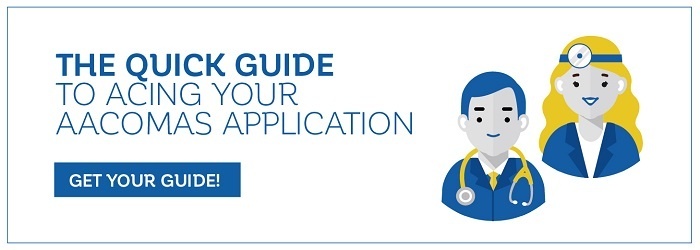

The Experiences section in the AACOMAS application asks you to list your non-academic work, including healthcare-related work, non-healthcare work, volunteer work, and extracurricular activities. The Achievements section is the space for you to include academic honors, awards and scholarships.
Below are five tips for completing this section of the AACOMAS.
- Categorize your activity by type.
The AACOMAS application doesn’t let applicants list hours twice. If your experience includes two different types of activities – like research and clinical work – divide the experience and hours into two separate categories (e.g. 10 hours research and 30 hours clinical work). The AACOMAS doesn’t have a section for publications and poster presentations. You should put them in the Achievements section.
- Focus on quality, not quantity.
There is no limit for AACOMAS Experiences, though there is a limit of 5 for Achievements. Use the AMCAS 15 activities limit total as a general guiding principle, keeping in mind AACOMAS does not ask you to identify the most meaningful activities among those you list as Experiences or Achievements. If you have related/overlapping experiences combine them into one entry (i.e. shadowed 3 Osteopathic doctors during the month of July). If you have duplicate achievements (Dean’s List, all semesters, University of Michigan, 2018-22) combine these as well. Do include work for pay. If you are a non-traditional student, do include professional work from a related or unrelated career even if a supervisor is no longer employed with the company. Then, give a general Human Resources contact number for employment verification.
Admissions committees aren’t impressed by a large number of activities that require minimum commitment. Instead, they look for depth of experience and time dedication. So, don’t pad your list or fill it up with “a day here, a day there” shadowing or volunteer work. These types of activities might best be bundled together or omitted if they seem less relevant than or detract from other key experiences.
- Include college and post-college experiences only.
Don’t include experiences from high school.
- Do not include future experiences.
If you haven’t started an activity yet, you should not include it in the AACOMAS experiences section. Hypotheticals, theoreticals and “not yets” aren’t experience. If an activity you had planned for got delayed or canceled due to Covid-19, do not list it in Experiences unless you’ve actually started it, albeit later than hoped. You will have an opportunity to address missed opportunities due to Covid-19 in a supplemental essay.
- Write in complete sentences.
When you describe your experiences, use complete sentences rather than bullet points. This simply adds to the professional appearance of your application. Follow the 600 character limit rule.
Remember that the experiences section of the AACOMAS is your opportunity to present non-academic achievements to the admissions committee. Use the space to impress the committee with your dedication, your compassion, your communications skills, and your leadership – with the non-academic, qualitative and human side of you. Include any outside interest that is truly a passion, especially those that require dedication, acceptance and/or certification. Do you scuba dive? Do you run half-marathons? Are you a sax player in a jazz band that plays summer festivals? Do you deliver Meals on Wheels?
Use the Achievements section to highlight academic achievement that goes beyond good grades and a solid GPA. Take a moment to think about this section of the application. Avoid replicating the educational accolades listed on your resume. Instead, tell the brief story that brought this recognition your way – especially if it demonstrates integrity, maturity and/or humility. The key to this section is to avoid bragging, avoid ego, avoid sounding competitive or repetitive. Build your character in the write-up of these achievements. A “best of” list evidenced by stats and numerics could be a missed opportunity for having provided insight, context and (inherent) values that likely led to a moment of recognition, even an academic one.
Are you a Scholar-Athlete but not necessarily the best player on the team? Why did you win this award? (Hint: the answer probably has something to do with dedication, inclusion and harmonious people skills. Can you show these skills at work rather than say you have them?) Did you win an academic award that was much more difficult for you to earn than others – for instance, if English is a second language, what actions and steps preceded winning an essay competition or a research grant?
You need to work hard if you want to submit a winning AACOMAS(or AMCAS or AADSAS) application — and we can help! Check out Accepted’s Primary Application Package to receive complete application guidance from conceptualization to final review. Your experienced consultant will guide you through the entire primary application, ensuring that you make the best use of your time to create a compelling portrait of yourself as a future leader in the medical field.

Dr. Mary Mahoney, Ph.D. has over 20 years of experience as an advisor and essay reviewer for med school applicants. She is a tenured English Professor with an MFA in Creative Writing from Sarah Lawrence College and a PhD in Literature and Writing from the University of Houston. For the last twenty years, Mary has served as a grad school advisor and essay reviewer for med school applicants. Want Mary to help you get Accepted? Click here to get in touch!
Related Resources:
- 5 Tips for Completing AACOMAS Secondary Applications
- 5 Tips for Requesting an AACOMAS Letter of Recommendation (Evaluation)
- 5 Tips for Perfecting Your AACOMAS Personal Statement
- What to Include in the AMCAS Work and Activities Section [With Examples] for 2022
The post 5 Ways to Stand Out in the AACOMAS Experience and Achievements Sections appeared first on Accepted Admissions Blog.


No comments:
Post a Comment